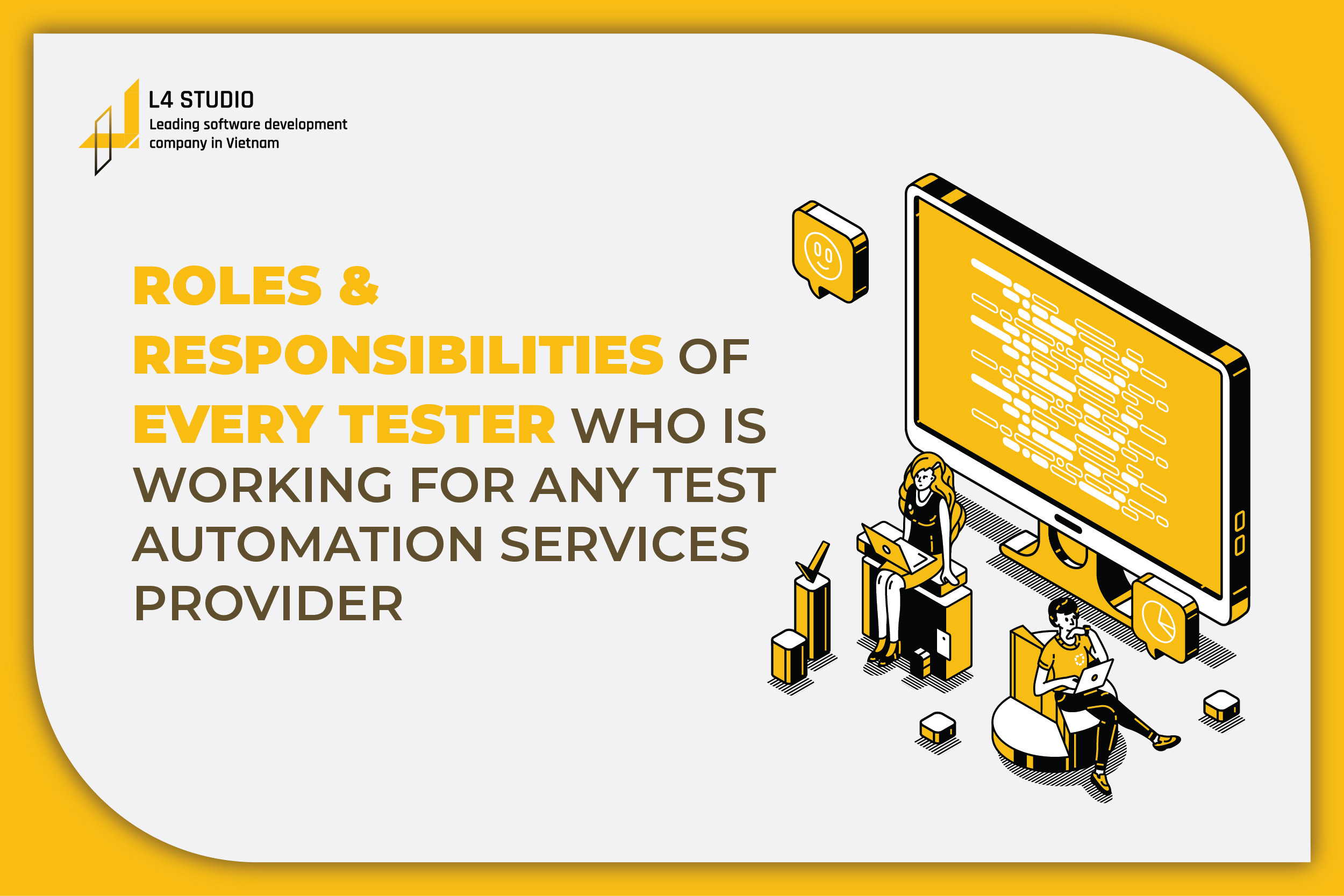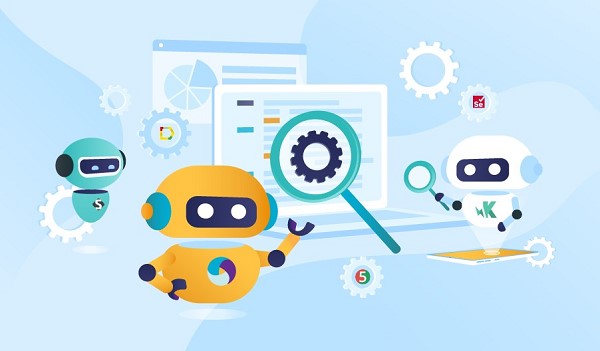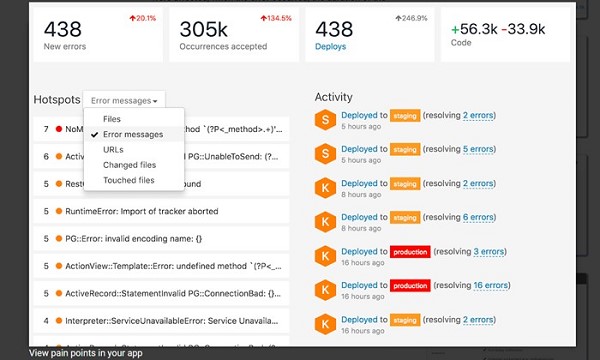
ROLES AND RESPONSIBILITIES OF EVERY TESTER WHO IS WORKING FOR ANY TEST AUTOMATION SERVICES PROVIDER
Test automation services are critical in determining the success of a software product. In many companies and even in each project, team composition specifies differently. The same is true for organizational structure. The distribution of software testing roles is determined by the project’s specifics as well as the testing budget. However, team location, knowledge, skills, and practical experience in software testing are also required. Leading elements of influence can shift over time, and that is why we have this kind of service. But how can their staff test your app?
1. BUT FIRST, WHY IS THERE SUCH A HIGH DEMAND FOR AUTOMATION TESTERS?
If you don’t test and implement, how will you adapt to changes? Test automation services save time and money while ensuring quality through resource optimization. Automation testing improves testing quality and reduces the possibility of human error in missing a requirement. They simplify the process for DevOps to make the necessary changes and generate an analysis that helps shape future courses of action that benefit the organization.

Figure 1. Automation testing helps reduce human effort and the chances of human error
2. AUTOMATION TESTER ROLES AND RESPONSIBILITIES
When discussing a tester’s roles and responsibilities, there are several tasks they must face daily. To handle these job responsibilities, advanced skill sets are required, which can be obtained through a credible QA Certification course. Here is a list of essential automation test engineer job duties that have been thoroughly examined:
2.1. TEST NEW SOFTWARE AND APPLICATIONS
This is the most important aspect of test automation services. They perform a variety of tests on new software to ensure that it meets all specifications and requirements and runs smoothly. They investigate any bugs that need to be fixed. Following the resolution of issues, QA testers conduct additional tests before releasing products for customer purchase.
2.2. HELP SOFTWARE DEVELOPERS TO ENHANCE THEIR CODE
To apply their knowledge early in the development lifecycle, test automation services collaborate closely with the software development team. They work closely with developers to identify potential operational issues, assess risks, and resolve issues before releasing the new program. This is also an important function for determining what the QA tester’s responsibilities are. Through their own comprehensive automation testing tutorial, you can learn more about the essential skills of an automation tester.
2.3. KEEP TRACK OF DEFECTS AND ISSUE REPORTS
Test automation services staff records and creates reports on all defects, which are then distributed for error correction. Creating and maintaining documents such as changelogs aids in the rapid resolution of problems.

Figure 2. Automation testing services have a delicate tool to help track the bugs during the developing progress
As you read the automation testing roles and responsibilities and understand what a test engineer is, you may be wondering why we need an automation tester if the system is already automated. You’ve probably heard of the term “technical glitches”; after all, technology is created by humans and must be maintained by humans as well. The role of the automation tester is important here.
3. TECHNICAL SKILLS REQUIRED TO PERFORM AUTOMATION TESTER ROLES AND RESPONSIBILITIES EFFICIENTLY
- Coding and scripting are the first two bases you should cover, along with knowledge and experience working with languages such as C and its variants, Python, Pearl, Java, SQL Ruby, and Shell.

Figure 3. Not only developers but automation testers also need to know how to code, too
- Troubleshooting and testing various solutions will also be one of their test automation services staff’s main skills as an automation engineer.
- Designing Tests and Execution – QA automation engineers create automated tests for application validation before developing execution plans to put these scenarios into action.
- Identification and Reporting of Bugs – QA automation engineers review bug reports and highlight problem areas. They then present the same information to the other stakeholders.
- Identify Quality Issues – QA automation engineers ensure that all quality checks are performed for the app to function properly.
Also, some other skill sets are not required for test automation services companies, but it is still nice to have:
- Using testing software on new software
- Detecting and resolving problems in new systems
- Make reports
- Making certain that new software products are consumer-ready.
- Collaboration with development teams to prevent problems with new products
4. SOFT SKILLS REQUIRED FOR AUTOMATION TESTER ROLES AND RESPONSIBILITIES
A test automation services staff’s duties and responsibilities require extensive communication and teamwork. Moving up the ladder is made possible by having potential soft skills.
- Establishing priorities clearly and identifying the issues that need to be handled right away. No matter how tempted you are to automate everything, it’s not necessary.
- Work together as needed with internal and external stakeholders. To develop the best solution, they collaborate closely with the engineering team’s other team members.

Figure 4. Softskills did not contribute to the overall performance of the automation tester but it enhance the progress of the test process
- Professionals with an eye for detail include QA automation engineers.
- High analytical skills are required for many roles and responsibilities of automation testers, including the creation of bug reports and task prioritization.
- QA automation engineers working for test automation services must be able to hunt down bugs and fix them using their problem-solving abilities.
- Communication abilities are essential. Strong verbal communication skills are necessary for QA automation engineers to collaborate with the engineering team effectively.
5. ROLES & RESPONSIBILITIES OF POPULAR SOFTWARE TESTING MODELS THAT TEST AUTOMATION SERVICES USUALLY HAVE
5.1. QUALITY CONTROL ENGINEER (QC)
The manufacturing sector is where the phrase originates. In the software industry, quality control is in charge of testing new products to see if they reliably and functionally meet business needs. Implements the test plan created by QA procedures working for test automation services vendor, focusing testing efforts on identifying flaws.
5.2. QUALITY ASSURANCE ENGINEER (QA)
They have a responsibility to establish test protocols that allow for the most effective testing of a specific software application. Creating test cases, test documentation, and test suite design. Executes testing at all levels. Run tests using various testing techniques following the test standards. Then finally, test automation services report test results after analyzing them before the product is pushed into production to assist in troubleshooting errors.
5.3. TEST ANALYST
In this role, they need to concentrate on their client’s business issues. This sector of test automation services must be able to think strategically, plan effectively, and be organized. Analysis of requirements and acceptance criteria, design of software testing documentation, including test plans, linking of tests to requirements, execution of tests, analysis of results, and documentation of results.
5.4. TEST CONSULTANT
Participate in all (SDLC) phases of an IT project so they can enhance all necessary software development aspects. They should be intrigued by the current software development trend (including Agile and DevOps). In addition to having excellent communication skills, one should be analytical in thinking.
5.5. TEST AUTOMATION ENGINEER (AQA)
The coding test framework comes first, followed by quality. To design and execute automated test cases, one must first set up a test environment and then develop test scripts using testing tools like Selenium, Concept, or others.
5.6. TEST ARCHITECT
Develops a test strategy, uses test automation tools and collaborates with the project infrastructure to support both product code and test code. Performs low-level testing, such as unit, module, performance, and acceptance testing, occasionally. Should be well-versed in backend services.
5.7. TEST MANAGER
QA managers behave somewhat similarly to project managers. Through test planning, you can create a test strategy, arrange test procedures, monitor test progress, and manage teamwork.
5.8. DIRECTOR OF THE TEST
An experienced manager who oversees test managers. Should be in charge of establishing the QA strategy and approach for all of the business’s products. Assure the accomplishment of all testing teams’ manual and automated testing efforts
Additionally, a lot of contemporary Agile QA teams are even more diverse. QA engineers, Test Analysts, Requirement Analysts, Test Architects, Test Managers, QA Team leads, and other QA roles may be present in large numbers. They occasionally share power and duties.
A manual QA engineer can partially or fill the role of a QA analyst or QA coordinator, except for carrying out manual testing. The project’s QA coordinator can also serve as the project manager.
6. Types of automation testing
6.1 UNIT TESTING
Unit testing is the process of testing individual units or components of an application in isolation. In unit testing, developers write test cases to verify the functionality of each method or function within a module or component. Unit testing is typically performed using automated testing frameworks, such as JUnit or NUnit.
6.2 INTEGRATION TESTING
Integration testing involves testing the interactions between different components or modules of an application. In integration testing, developers test how different parts of the application work together to achieve the desired functionality. Integration testing is critical in ensuring that the application is stable and functions as expected.
6.3 FUNCTIONAL TESTING
Functional testing is the process of testing the application’s functionality to ensure that it meets the business requirements. Functional testing is performed by executing test cases that validate the application’s behavior and expected output. Functional testing is typically performed using automated testing frameworks, such as Selenium or Appium.
6.4 REGRESSION TESTING
Regression testing is the process of testing changes to an application to ensure that they do not have an adverse effect on the existing functionality. Regression testing is typically performed after any changes are made to the application, such as bug fixes or new feature implementations.
6.5 PERFORMANCE TESTING
Performance testing is the process of testing an application’s performance under various conditions, such as high traffic, heavy loads, or peak usage times. Performance testing is typically used to identify and fix bottlenecks in the application’s architecture to ensure that it performs as expected under all conditions.
6.6 SECURITY TESTING
Security testing is the process of testing an application’s security to identify vulnerabilities or weaknesses that could be exploited by hackers. Security testing is typically performed using automated testing frameworks, such as OWASP ZAP or Burp Suite.
6.7 ACCEPTANCE TESTING
Acceptance testing is the process of testing an application’s suitability for use by end-users or stakeholders. Acceptance testing is typically performed by the client or end-user to validate that the application meets their business needs and requirements. Acceptance testing can be performed using both automated and manual testing methods.
6. TOOLS FOR AUTOMATION TESTING
There are several tools available for automation testing, each with its own strengths and weaknesses. Here are some of the most commonly used tools for automation testing:
6.1 Selenium
Selenium is one of the most popular open-source tools for web application testing. It supports various programming languages, including Java, Python, C#, and Ruby. Selenium offers a range of features for web testing, including the ability to record and replay tests, test on multiple browsers and platforms, and support for parallel testing.
6.2 Appium
Appium is an open-source tool used for testing mobile applications. It supports both Android and iOS platforms and can be used for native, hybrid, and mobile web applications. Appium uses the WebDriver protocol to automate mobile applications, making it similar to Selenium.
6.3 TestComplete
TestComplete is a commercial testing tool used for desktop, web, and mobile applications. It offers a variety of features for automated testing, including object recognition, keyword-driven testing, and support for multiple scripting languages.
6.4 Katalon Studio
Katalon Studio is a free and powerful automation testing tool for web, API, and mobile applications. It offers a range of features, including record and playback, scriptless automation, and integration with other tools.
6.5 HP Unified Functional Testing (UFT)
HP UFT is a commercial testing tool used for functional, regression, and GUI testing of desktop and web applications. It supports multiple scripting languages, including VBScript, and offers a range of features for automated testing.
6.6 Appium Studio
Appium Studio is a commercial testing tool based on Appium that offers a range of features for mobile application testing. It includes support for iOS and Android applications, visual testing, and advanced debugging capabilities.
6.7 JMeter
JMeter is an open-source tool used for performance testing of web applications. It can be used to simulate a high load on a web server, and it offers a variety of features for performance testing, including support for different protocols, scripting, and reporting.
SUMMARY
Test automation Engineers are simply builders who work on the designing, programming, simulating and testing of new or existing software. Automation testing, on the other hand, is a method of testing software programs to compare the output produced with the output anticipated or assumed. This method of test automation services can be redundant, so programmers create and generate applications so that this task can be carried out automatically with less human effort than traditional in-house testing.
Source: Internet
——————————
L4 STUDIO – LEADING SOFTWARE DEVELOPMENT COMPANY IN VIETNAM
Website: https://l4studio.net/
Email: hi@l4studio.net
Phone: (+84) 28 6675 6685
Our Mobile App Development Services: https://l4studio.net/mobile-app-development/
For more exciting blogs: https://l4studio.net/it-knowledge/
Follow us at: https://www.facebook.com/L4Studiovn/
Read more:








